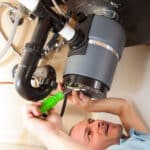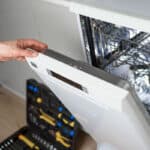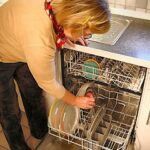We all love the convenience of our favorite kitchen appliances, but when you have a dishwasher not draining, you may panic, dollar signs floating around your head. Opening your dishwasher’s door to the sight and smells of standing water in the bottom of the tub is never a pleasant experience. Fortunately, this issue doesn’t necessarily mean it’s time to call a plumber or pay for a new appliance. If you’re looking for a way to solve a dishwasher not draining problem, there may be a simple and inexpensive fix.
Steps to Solve Dishwasher Not Draining
When your dishwasher isn’t draining correctly, follow these steps to diagnose and fix the issue:
1. Disconnect the Power and Remove the Toe-Kick
Before you start DIY repairs on any home appliances, make sure your environment is safe and accessible. Fixing a dishwasher not draining is no different. First, disconnect the power to the dishwasher by either unplugging the appliance or turning off the circuit breaker. Then, remove the panel by the floor, called a toe-kick. (This panel is typically held on with a few screws, so grab your tool kit.)
2. Check the Filter
You might be able to solve the issue of your dishwasher not draining by simply cleaning or replacing the filter on newer dishwasher models. Older dishwashers have built-in grinders for food, but larger pieces of food and debris can get stuck in the motor. Check the owner’s manual that came with your dishwasher to see which feature is present in your appliance, then locate the filter or the grinder (usually found either at the bottom of the tub or in the back of the machine) and clean out any debris, caked-on food, etc.

3. Run Your Garbage Disposal
If the garbage disposal in your kitchen sink is full of food or an air gap is present in the disposal hose, water cannot properly drain from your dishwasher. You may be able to fix the issue by simply running your garbage disposal for about 30 seconds.
Related: How To Troubleshoot Your In-Sink Garbage Disposal
4. Inspect the Drain Hose
There is a reason why dishwashers are installed close to your kitchen sink. The dishwasher needs the sink’s plumbing to work correctly. If the preceding steps didn’t work to get your dishwasher draining again, check the drain hose that leads from your dishwasher to your kitchen sink. Straighten any kinks you see in the hose and inspect for wear and tear. You may also consider disconnecting the drain hose and cleaning it to remove any clogs.
5. Check the Drain Valve
To prevent dirty water from flowing back into the dishwasher, many dishwashers (especially older models) have a drain valve, usually located behind the toe-kick of the appliance. Inspect the drain valve and bracket by pushing on it to ensure the valve isn’t stuck and will move freely.
6. Loosen Any Clogs
If these efforts don’t get the water flowing out of your dishwasher, you may be dealing with a more significant clog that needs to be dissolved. We recommend mixing one cup each of vinegar and baking soda and pouring the mixture into the standing water. If the water shows signs of draining after about 20 minutes, run your dishwasher’s rinse cycle to complete the process.
Get Help With Your Dishwasher Not Draining
If our troubleshooting tips for your dishwasher not draining don’t get you back in business, you may need a more trained set of eyes on the issue before giving up the fight.
The specialists at Reliable Appliance Repair can often diagnose and fix your dishwasher much more affordably than it would cost to replace it. For more than 30 years, our appliance repair professionals have been helping customers throughout the Colorado Springs area solve issues like a dishwasher not draining. Contact us today to schedule service or for a free quote.




